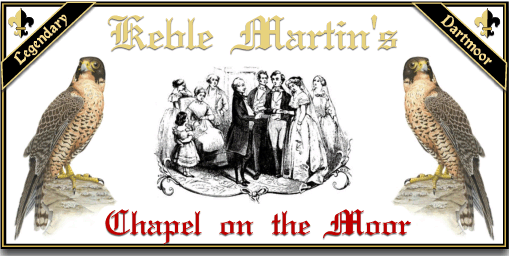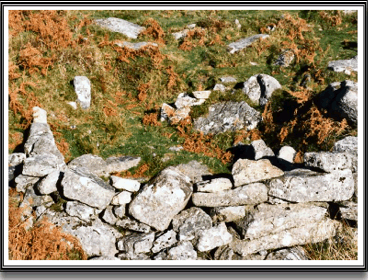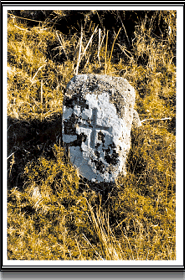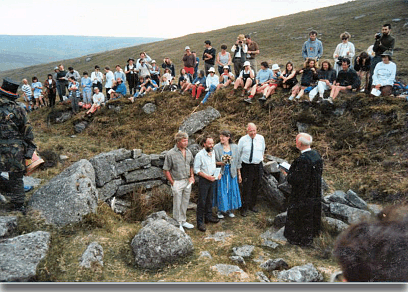
The remote area around Huntingdon Warren shows many examples of human activity including the remains of prehistoric huts, the old rabbit warren, remnants of the old Huntingdon Mine, and features of early monastic use by the brothers of Buckfast Abbey. Here in the valley the Western Wella Brook cascades down to meet the River Avon and on its left bank are some small ruins. At first these seem to be nothing special, simply the remains of possible mining activity but the place is known on the moor as ‘Mattins Corner.’ Perhaps this would suggest that it was an old shelter that the Buckfast monks used whilst tending their flocks so many centuries ago? In reality one only has to go back about a hundred years to learn the answer. Mattins Corner and the small ruins are in fact a chapel which was built in 1909 by Keble Martin and his companions.
Keble, Arthur, and Jack were the sons of the Rev. Martin of Dartington and in 1904, along with some friends, they all embarked on a camping holiday to the moor. This was to be the first of many such vacations over the next 9 years which were spent beside the Wella Brook. They would stock up with provisions and cycle up to Hayford Hall where the bikes would be left for safekeeping. The boys would then hike the mile and a half to their annual campsite. At this time Huntingdon Warren was still occupied and so fresh milk, eggs, bread, and the odd rabbit were supplied by Mrs Pearce the warrener’s wife. Keble Martin in his autobiography also mentions that whilst in residence at the camp they would get daily postal deliveries. He also describes life at the camp:
“Each year we blocked the tumbling brook, the Warren Stream, with rocks in order to make a bathing pool, into which we could take headers, i.e. dive in the early morning sunshine. The stream and the pool were full of trout. And after catching about a hundred, there were nearly as many in the pool on the last day. We also had permission from the Duchy of Cornwall to shoot rabbits… We had a little sheltered gulley in the rocks, which was our church, and Arthur inscribed a cross at one end on an erect stone. We had morning service here and called it Mattins Corner…“, Keble Martin, 1968, p.66.
From the description of the camp it sounded the ideal spot for a summer holiday apart from one thing, Keble Martin, p.67, casually mentions that, “There were adders in the private corners of the camp, but we took no harm from them“. But on the other hand he then goes on to describe how:
“One day we slept in the afternoon and then went up to the moor top near Aune head and lay up at night. The dew was very heavy. In the midsummer midnight twilight we watched foxes hunting with dripping wet coats. The red grouse were calling warnings to their chicks, sounding like “Go back, go back, go back”. Before sunrise the sky became filled with skylarks singing their prime; then they all came down and fed hurriedly on caterpillars, and as the sun broke the horizon, they all went up again and stayed up singing lustily. They were many and seemed utterly happy. Nature is very beautiful“.
Both Keble and Jack Martin had decided to follow in their father’s footsteps and become men of the cloth hence the reason for building the little ‘chapel’. It was during one of their visits in 1905 that the warrener’s daughter was due to be baptised and so on the 2nd of August Jack Keble, who was the Curate at Dartington, christened the girl Vera Millicent Pearce. The service was held in the warren house and the ceremony was then entered into both the Buckfastleigh and Princetown parish registers. Keble Martin was also a keen botanist and later went on to write ‘The Concise British Flora’.

Keble Martin’s Chapel – G. I. Bentley 1997
The actual ‘chapel’ measures roughly 5 x 3.5 metres and the walls stand at around 1.2 metres. At the northern end is the small ‘erect’ stone that Arthur Keble inscribed the cross on. Hemery considers that originally the stone was an old tinner’s boundstone, Hemery, 1983, pp 314-5
At the southern end of the building is a small with a ‘Chi Rio’ symbol carved on it. Oddly enough Keble Martin does not mention the ‘Chi Rio’ symbol nor does Hemery in his description which could possible indicate that the symbol was added at a later date.

The Small ‘Altar’ Cross
Caroline Atchley and Derek Newman first met whilst out letterboxing and supposedly visited Mattins Corner whilst looking for boxes. They eventually decided to get married and on the 12th of May 1990 the ceremony took place at the Newton Abbot registry office, nothing unusual about that. What was extraordinary was that the blessing of the marriage was held at Keble Martin’s Chapel. The groom camped out on the moor overnight and then the following day the bride, Rev. Eric Carless, and several guests then traipsed across the moor to the chapel, Stanbrook, 1990 p.2. Caroline has since contacted me and added to the story relating how the couple actually first met at the Ten Commandments Stones and that on their 10th wedding anniversary they went back to Keble Martin’s chapel where the Reverend Carless held another short service.

The Wedding Ceremony – by kind permission of Derek Newman © 2009
It is a trifle ironic that the Reverend’s name was Carless because to reach that service he couldn’t have used one anyway.
The little twist to this place is that here we have a little chapel that was obviously built by God fearing and pious men for acts worship. A couple have actually had their wedding blessed in this sacred spot – ok fine. If you look up the six figure grid co-ordinates for Mattins Corner they are SX 666 666. Mention 666 and to me that conjures up two things, The Omen and …
“And he causeth all, both small and great, rich and poor, free and bond, to receive a mark in their right hand, or in their foreheads:
And that no man might buy or sell, save he that had the mark, or the name of the beast, or the number of his name.
Here is wisdom. Let him that hath understanding count the number of the beast: for it is the number of a man; and his number is Six hundred threescore and six.”
Revelation 13:16:18

Hemery, E. 1983, High Dartmoor, Hale, London.
Martin, W. K. 1968 Over the Hills, Michael Joseph, London.
Stanbrook, E. 1994, Dartmoor Forest Farms, Devon Books, Tiverton.
Stanbrook, E. (Ed) 1990 The Dartmoor Magazine No. 20, Quay Publications, Brixham.
 Legendary Dartmoor The many aspects past and present of Dartmoor
Legendary Dartmoor The many aspects past and present of Dartmoor
